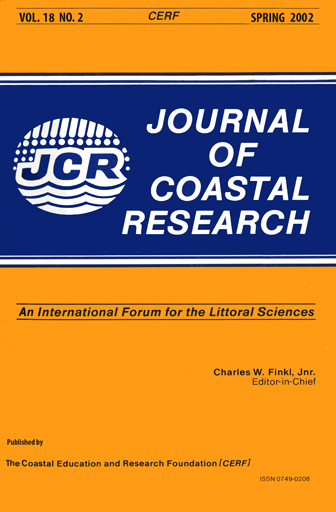Long-Term Analysis of Trends in Shore Protection Based on Papers Appearing in the Journal of Coastal Research, 1984-2000
Keywords:
Beach erosion, beach nourishment, coastal erosion, coastal engineering, environmental management, shore erosionAbstract
The Journal of Coastal Research (JCR), an international coastal/marine science journal, deals with all aspects of coastal research. Shore protection is an applied discipline that is mainly conducted by coastal engineers, but which receives background support in the geological and oceanographic sciences. When seen from the purview of coastal engineering per se (51 papers) and ancillary environmental (empirical) studies of natural process (113 papers), related numerical and quantitative (modeling) studies (49 papers), biophysical impacts of coastal structures (39 papers), and economics and policy (3 papers), there were about 255 papers in the JCR fitting these broad categories. These specializations averaged about 21% of all papers in any particular volume over the period of study. The percentage of shore protection papers by volume for 16 volumes (1984-2000), four issues each per year, ranged from 11.5% (1985) to 29% (1991). Prominent trends include increasing numbers of studies that analyze shoreline position, more numerous studies of coastal environmental impacts from shore protection structures, and steady flow of papers dealing with shore protection. These decadal trends reflect increasing awareness of natural erosion trends as well as those exacerbated by engineering works, including structures that are designed to mitigate erosion but which have unwanted effects. Somewhat surprising are trends that evaluate the performance of shore protection efforts, such as beach replenishment, as well as introspection of cost-benefit analyses used to justify beach projects. Accountability became a controversial issue that was associated with predictions of design life and durability of beach projects. The great beach nourishment debates raged through the 1990s and continue today after curtailment of federal participation in most new beach restorations. A recent minor trend focuses attention on controversial aspects of coastal modeling in the service of shore protection. Different schools of thought surfaced as debaters considered application of numerical models under a variety of shore conditions. Another important trend features overarching and increasing concerns to better understand basic coastal biophysical processes, as they are incorporated into the practice of shore protection, within the context of rapidly changing political and socioeconomic regimes around the world. This emerging insight conditions policy that steers research directives in the coastal zone. Rationalization of shore protection measures is a new and productive trend that fosters research and technology transfer to the management sector.


